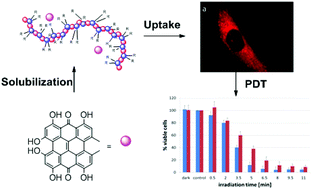Applicability of new degradable hypericin–polymer-conjugates as photosensitizers: principal mode of action demonstrated by in vitro models†
Abstract
Two series of water soluble novel conjugates of the photosensitizer hypericin were prepared and evaluated for their use as agents for photodynamic therapy, with covalently and non-covalently loaded hypericin on functionalised, hydrolytically degradable inorganic–organic hybrid polyphosphazenes. The conjugates showed excellent aqueous solubility and similar fluorescence spectra to pristine hypericin. Detailed in vitro investigations revealed that the substances were non-toxic in the dark over a wide concentration range, but displayed phototoxicity upon irradiation. Cell uptake studies showed rapid uptake with localization of hypericin observed in endoplasmic reticulum, Golgi complex and particularly in the lysosomes. Furthermore, a DNA fragmentation assay revealed that the photosensitizer conjugates are efficient inducers of apoptosis with some tumor cell selectivity caused by faster and enhanced accumulation in A431 than in HaCaT cells, and thus a moderately higher phototoxicity of A431 compared to HaCaT cells. These novel photosensitizer conjugates hence represent viable hydrolytically degradable alternatives for the advanced delivery of hypericin.


 Please wait while we load your content...
Please wait while we load your content...